"Birdy" (easily guessable) Names Formed with 鳥 neau / niǎo
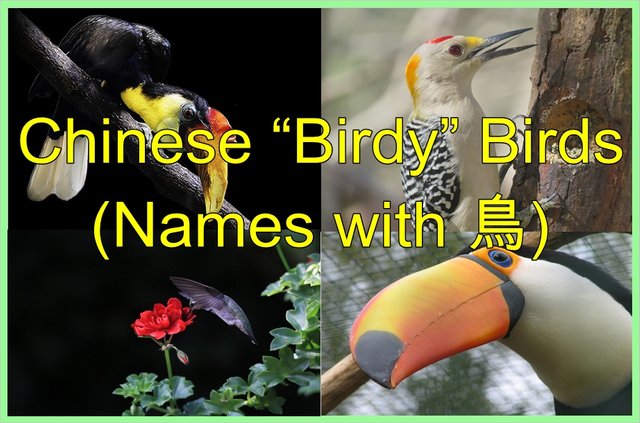
Most #chinesewords are made from pure #chinese elements. This makes them much easier to guess and remember than English words, which are often created from Greek and Latin roots (or borrowed from other languages: not so common in #mandarin Chinese). This is why Chinese people rarely consult Chinese dictionaries after leaving middle school: most vocabulary is either self-explanatory or can be easily guessed from context.
The #bird names discussed in this article are good examples of the transparent nature of Chinese compounds (what I call "birdy" bird names: there are a small number of not easily guessable names).
toucan
Although the #toucan itself is very easy to recognize, the English name (from a South American language) is not so easy to remember. The Chinese is so simple that even a foreign beginner can instantly recognize and remember the name: 大嘴鳥 dàzuǐ niǎo / dahtzoeineau “[literally] the big mouth bird”. What could be simpler?
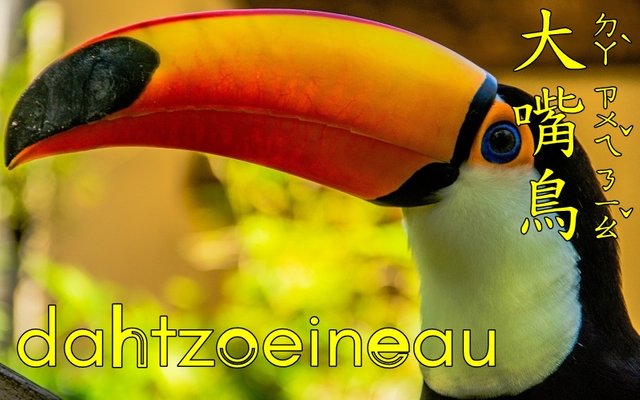
hummingbird
Because of how fast their wings beat, the English name #hummingbird seems very appropriate, but the Chinese is even better: 蜂鳥 fēngniǎo / fengneau “[literally] the bee bird” describes its size, the sound it makes and even the way hummingbirds feed on flowers.
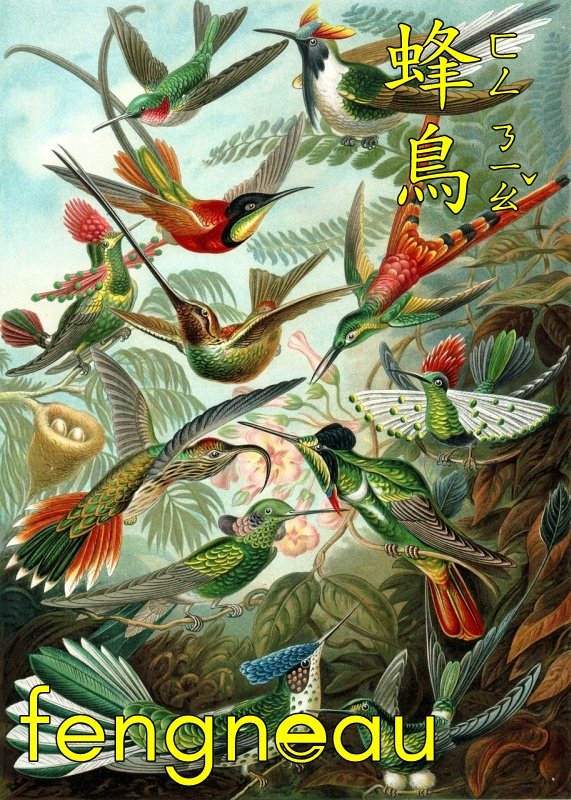
@marcoagarcia3rd, a fellow Steemian, has managed to tame a hummingbird to rest on his index finger while feeding. On his video, you can clearly hear the humming of the wings. I'm very impressed!
https://steemit.com/nature/@marcoagarcia3rd/how-to-tame-wild-hummingbirds
woodpecker
Just like English speakers, Chinese people choose a name for the #woodpecker that befits its nature, 啄木鳥 zhuómùniǎo / jwomuhneau “the treepecking bird”.
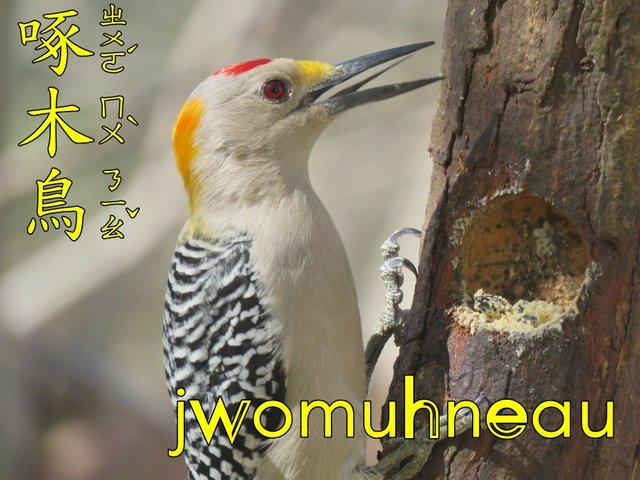
Of course, some people might be slightly dissatisfied with my literal #translation. Doesn’t 木 mù / muh mean “wood?” Not really. It is important to remember that compound words are usually formed from #classicalchinese elements (文言文 wényánwén / wenyanwen). In fact, 木 means “tree” in Classical Chinese (木, originally a stylized drawing of a tree, is a modern form of one of the small number of pictograms used in written Chinese).
BTW, 啄 zhuó / jwo means “peck”, but it only refers to what birds do when searching for food, or otherwise (not what domineering wives do to their husbands), as in this introduction to an article written by a veterinarian:
雞的互啄惡習,被認為是許多原因所造成
Jī de hùzhuó èxí, bèi rènwéi shì xǔduō yuányīn suǒ zàochéng
Ji de huhjwo ehshyi bey rennwei shyh sheuduo yuanin tzawcherng
“The unfortunate tendency of chickens to peck at each other has been ascribed to many factors”
@artmonkey, a fellow Steemian, is very lucky. She can watch woodpeckers from inside her living room:
https://steemit.com/birds/@artmonkey/living-room-bird-watching
hornbill
In Chinese, the #hornbill is very appropriately called the #rhinoceros bird: 犀 xīniǎo / shineau, obviously referring to the horn on its beak/bill.
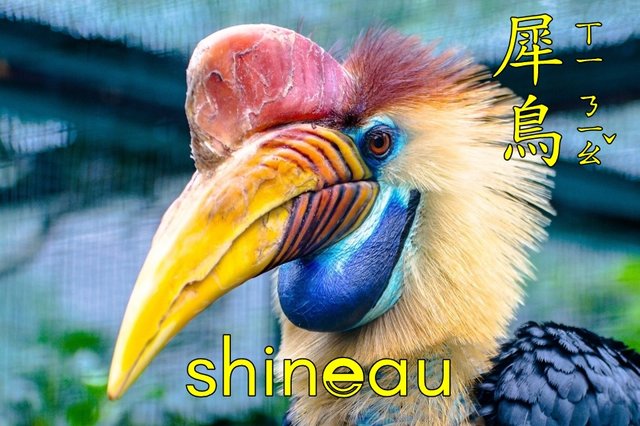
犀 is now a bound morpheme that means “rhinoceros” (a bound morpheme is a word-forming element that can only form an independent word when combined with another morpheme). In Modern Chinese (Mandarin) 犀牛 xīniú / shiniou “rhinoceros” is a two-character (two-morpheme) compound.
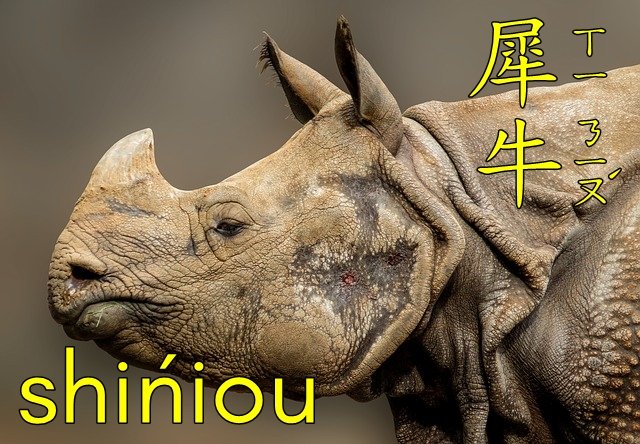
GR Tonal Spelling Notes
(1) 1st tone characters are the default (they are left unmarked). The only exception is syllables beginning with voiced initials (m-, n-, l- and r-), which almost never occur in the 1st tone. The acute accent above the ń in 犀牛 shińiou is inserted as a reminder to Chinese beginners that 牛 ńiou is a second tone character.
(2) One more point worth noticing is that the loudest, most prominent vowel sound in 牛 -o- is mysteriously missing in Hanyu Pinyin, i.e. niú should actually be spelled niÓu , with the second tone mark in the correct place.
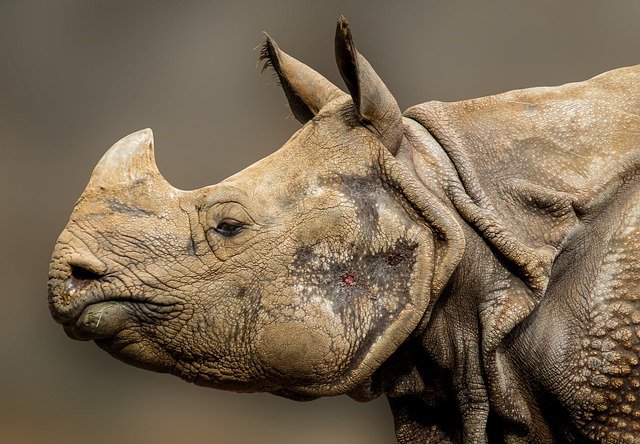
In the Nán Shǐ / Nan Shyy 南史 History of the Southern Dynasties (compiled in 659) there is a description of a rhinoceros: 外國獻生犀,其形甚陋 wài guó xiàn shēng xī, qí xíng shén lòu / way gwo shiann sheng shi, chyi shyng shenn low “a live rhinoceros was offered as tribute, and its appearance was exceedingly ugly.” The rhinoceros has been known in China since long before that” the name appears in the earliest Chinese dictionaries, an indication that these animals were occasionally offered as tribute, either from present-day Burma, India, Java or Sumatra.
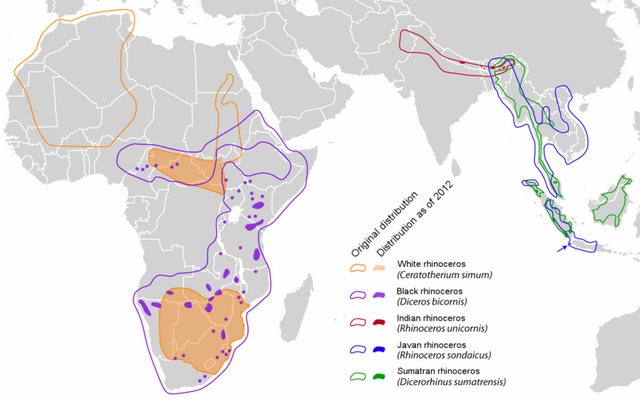
[CC--BY-SA NordNordWest]
It is sad to note that modern day rhinos have a much-reduced range. It is estimated that there are only about 100 rhinos left in Sumatra, for example. What's more, their habitat has been broken up, so these animals probably have great difficulties mating.
kingfisher
There are many species of #kingfisher. 翠鳥 cuìniǎo / tsueyneau is the most common Chinese term. 翠綠 cuìlǜ / tsueyliuh is often translated as emerald green, a very apt description of this lovely bird’s plumage. Because of their great skill at catching fish, kingfishers are also called 魚狗 yúgǒu / yugoou “[literally] fish dogs”. This series of photos is a lovely reminder of how they fly up out of the water after seizing a fish.
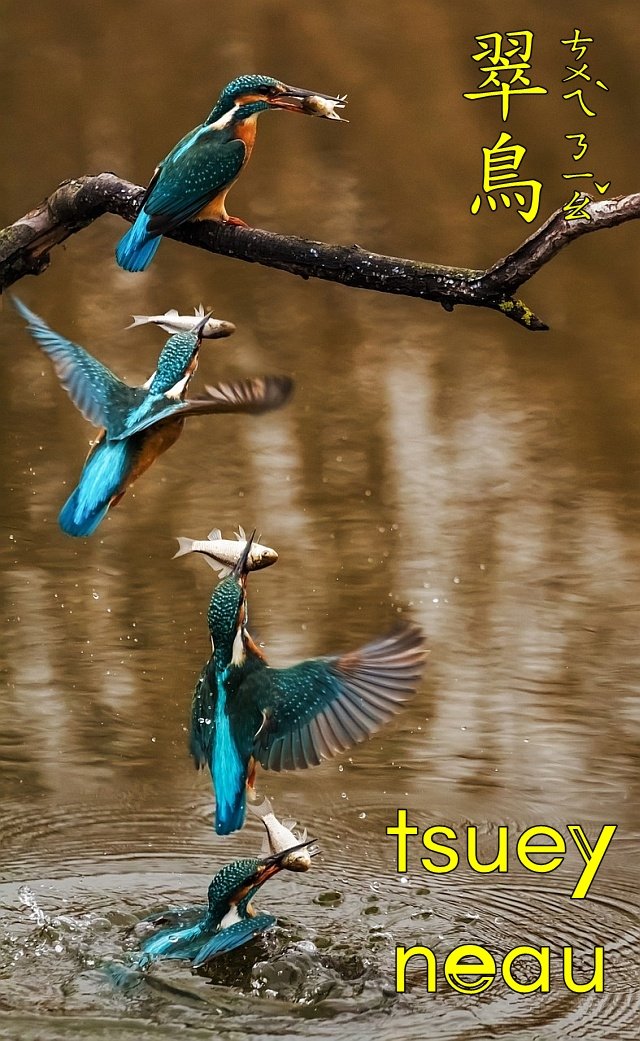
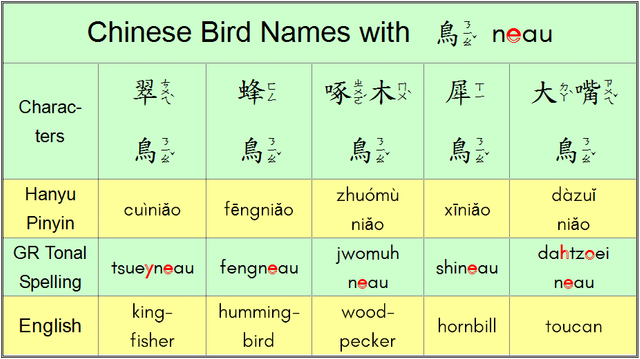
[A summary of the bird names presented in this posting]
Notice how the hollow, outline portions of semivowel glides in GR Tonal Spelling serve as visual #mnemonics for the tone contours. Such spelling tricks make good use of western psychology: diacritics are hard for English speakers to relate to: spelling Chinese tones makes them much easier for foreign beginners to remember. It also helps to distinguish false homonyms (Chinese words or syllables with the same vowels and consonants, but different tones).
Note: All illustrations in this posting were constructed from public domain photos available from #pixabay, a treasure trove which I gratefully acknowledge.
All Chinese words in the text proper are romanized in #hanyupinyin, the current government standard, and #grtonalspelling ( #gwoyeu), the older government standard, which is much easier for foreign beginners to correctly pronounce and remember. The illustrations are annotated in Chinese characters with #bopomofo ruby text (Zhuyin Fuhao) and GR Tonal Spelling.
I would enjoy hearing from readers who wish to comment and add details (or correct them: I’m only human :-).
A previous article in this series focused on non-birdy birds (animals whose names do not show that they are birds):
https://steemit.com/cn/@wentong-syhhae/non-bird-birds
More critters:
Six Legs Bad, Four Legs Good: More Characters with the 虫 radical (shiyih ching’ua lay har.ma rongyuan bianfwu tsyhwey 蜥蜴 青蛙 癩蛤蟆 蠑螈 蝙蝠 刺蝟)
https://steemit.com/animals/@wentong-syhhae/six-legs-bad-four-legs-good-more-characters-with-the-radical-shiyih-ching-ua-lay-har-ma-rongyuan-bianfwu-tsyhwey
Who I am:
https://steemit.com/introduceyourself/@wentong-syhhae/enthusiastic-intp-polyglot
Uncomplicated article. I learned a lot of interesting and cognitive. I'm screwed up with you, I'll be glad to reciprocal subscription))
The following public domain (PD, CC 0) images were all downloaded from Pixabay:
toucan
https://pixabay.com/en/toucans-bird-556025/
https://pixabay.com/en/toucan-bird-bill-colorful-close-up-245174/
hummingbirds
https://pixabay.com/en/hummingbirds-birds-trochilidae-63107/
https://pixabay.com/en/hummingbird-flower-bird-nature-2747561/
hornbill
https://pixabay.com/en/animal-bird-hornbill-175033/
https://pixabay.com/en/wrinkled-hornbill-hornbill-colorful-1352493/
https://pixabay.com/en/rhino-horn-pachyderm-zoo-big-game-936288/
woodpecker and kingfisher
https://pixabay.com/en/woodpecker-bird-wildlife-nature-3184234/
https://pixabay.com/en/kingfisher-bird-alcedo-atthis-1338235/
Resteemed your article. This article was resteemed because you are part of the New Steemians project. You can learn more about it here: https://steemit.com/introduceyourself/@gaman/new-steemians-project-launch